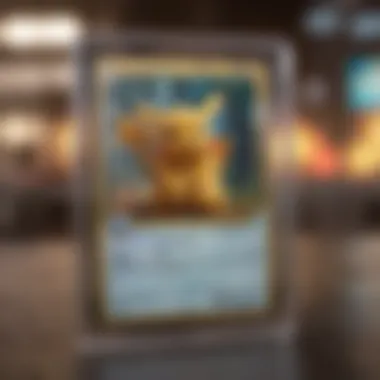Unraveling the Mystique of Rare Pokémon Card Values


Intro
The world of Pokémon cards has developed into a thriving community that celebrates nostalgia, competition, and investment. Among these collectibles, the rarest Pokémon cards have taken on a life of their own, achieving prices that seem unfathomable. Their rarity and significance are driven by factors including demand, historical relevance, and grading. Understanding the intricate dynamics within this market is crucial for collectors and enthusiasts alike.
In this article, we will explore how the value of these cards is assessed. We will discuss the critical aspects that influence their worth, including the impact of supply and demand, condition grading, and the historical context surrounding specific cards. Through this examination, we aim to equip collectors with the knowledge necessary to navigate the complex landscape of rare Pokémon cards effectively.
Industry Insights
Latest Trends in the Collectibles Market
The collectibles market has seen dramatic fluctuations over recent years. Rare Pokémon cards have surged in popularity, often outperforming expectations in value. Influencers and online platforms like eBay and Reddit have amplified interest in specific cards, leading to sharp price increases. This trend has extended to social media, where discussion on authenticity and valuation is prevalent.
Additionally, the COVID-19 pandemic has led many individuals to turn toward nostalgic hobbies, further driving demand for Pokémon cards. A shift towards digital grading has also emerged, where experts grade cards' conditions online through high-resolution images, making it easier for collectors worldwide to assess values remotely.
Behind-the-Scenes of Major Auctions
Significant auction houses such as Heritage Auctions and PWCC Marketplace have become key players in the Pokémon card market. Auctions for rare cards have attracted significant media attention, often resulting in record-breaking sales. These events often reveal not only market trends but also the community's pulse. High-profile sales can boost the perceived value of entire sets, influencing both buyers and sellers.
The Role of Grading Services
Grading services like PSA (Professional Sports Authenticator) and BGS (Beckett Grading Services) play a vital role in determining a card's value. The condition of a card heavily influences its market value, and professional grading provides a reliable assessment for buyers. Cards in pristine condition receive higher grades and, in turn, fetch substantially higher prices. Understanding the grading scale—ranging from 1 (poor) to 10 (gem mint)—is essential for collectors to evaluate the potential value of their collections.
"A card’s value can drastically change based on its condition, and understanding grading can significantly impact how collectors assess their items."
In summary, the rare Pokémon card market is shaped by a combination of trends, auction dynamics, and grading standards. Collectors must stay informed about these factors to make educated decisions regarding their investments.
Preamble to Pokémon Card Collecting
Understanding Pokémon card collecting is essential for anyone looking to navigate the multifaceted landscape of rare Pokémon cards. This journey begins with the realization that collecting is not merely a hobby; it is a complex interplay of nostalgia, strategy, and financial acumen. The significance of this topic lies in its ability to link personal passion with potential investment opportunities. Collectors must be aware of various aspects—from card rarity to market trends—to make informed decisions.
Overview of the Pokémon Trading Card Game
The Pokémon Trading Card Game (TCG) is more than just a game; it is a global phenomenon deeply rooted in the lives of enthusiasts. Launched in 1996, the game allows players to use their decks to battle opponents, fostering a sense of competition and strategic thinking. Cards are categorized into types, each with unique abilities. This diversity within the game enhances its appeal and encourages collectors to amass cards that not only serve gameplay purposes but also hold sentimental value and investment worth.
The Pokémon TCG has evolved over the years, introducing innovations such as special rare cards, intricate game mechanics, and limited editions. Players and collectors often find themselves drawn to cards that have historical significance or a strong following within the community. The game creates opportunities for personal expression and financial speculation.
The Rise in Popularity of Collecting Pokémon Cards
In recent years, the popularity of collecting Pokémon cards has witnessed a remarkable resurgence. Several factors contribute to this trend. The nostalgia associated with childhood memories of Pokémon has prompted many adults to revisit their past by collecting cards. This rekindling of interest has led to higher demand, significantly driving up prices in the market.
Furthermore, social media platforms like Reddit and Facebook have facilitated communities where collectors can share stories, trade cards, and even showcase their collections. These platforms boost visibility and accessibility, allowing new collectors to enter the market with relative ease.
Another important aspect is the influence of high-profile sales. Auctions featuring rare cards, such as the Illustrator Pikachu or the 1999 First Edition Charizard, have captivated audiences and ignited interest in the world of collecting. These events not only represent potential financial investment but also elevate the status of certain cards in the eyes of collectors.
In summary, Pokémon card collecting stands as a testament to both personal passion and investment strategy. The community behind it continues to grow, further intertwining people with a shared love for these collectible cards.
Understanding Rarity in Pokémon Cards
Understanding rarity in Pokémon cards is essential for collectors and investors alike. It determines the value of a card in the bustling collectibles market. When a card is deemed rare, it often carries a higher price tag. This principle applies directly to a collector's strategy and investment decisions.
Rarity involves several factors, such as how many copies exist, their demand, and the context of their release. Collectors often seek rare cards, viewing them as not just items of play but also as potential financial assets. Therefore, understanding rarity helps collectors make informed choices about purchasing or selling cards from their collections.
The assessment of rarity enables collectors to navigate the vast market and identify cards that could appreciate over time. It also brings clarity to the price fluctuations seen within the market, as rarity impacts desirability significantly.
What Constitutes Rarity?


Rarity is often defined by the scarcity of a card, which can stem from several elements. These include limited print runs, promotional releases, and the number of existing cards that have been preserved well or graded highly.
A card can be deemed rare not only based on how many were made but also on its significance in-game context or as a collector's item. Factors such as artistic value and historical significance also contribute to a card’s rarity, further complicating the valuation process.
Rarity is not merely about scarcity but also about the context in which a card was produced and how it resonates with the collecting community.
Types of Rare Cards
Different types of rare cards contribute uniquely to the overall understanding of rarity in Pokémon cards. Each type has its own characteristics and potential market value.
Limited Edition Cards
Limited edition cards are often produced in small quantities, making them highly sought after. The specific aspect of limited edition cards is their controlled print run. This trait significantly boosts their appeal and value in the market.
Key characteristics: Limited edition cards typically come with unique features, such as special artwork or alternative card framing. They are often released during significant company anniversaries or special events.
Their limited nature ensures that collectors perceive them as exclusive and prestigious assets. However, the downside is that some collectors may find it challenging to locate these cards due to their scarcity, which can drive prices even higher, potentially leading to speculation.
Promotional Cards
Promotional cards are generally issued to promote specific events, products, or campaigns. These cards usually have a unique feature that distinguishes them from regular cards, such as special holographic artwork.
Key characteristics: Unlike standard cards, promotional cards often serve a dual purpose. They are not only playable assets but also collector's items due to their limited availability during promotional periods.
While they can take on significant value, collectors must be wary of counterfeit promotional cards in the market. As a result, obtaining these cards requires careful verification.
Error Cards
Error cards arise from manufacturing mistakes during production. These errors can include misspellings, incorrect information, or misprinted artwork. The rarity of error cards lies in their unique mishaps, which make them standout pieces in a collection.
Key characteristics: Error cards are appealing because they tell a story. They often create a sense of curiosity and historical significance as they deviate from the norm.
While these cards can fetch high prices, the focus on errors can also divide collectors. Some prefer pristine, accurate cards, while others cherish the imperfections.
Graded Cards
Graded cards are assessed by professional grading agencies, which evaluate their condition and authenticity. The grading process adds a layer of credibility and assurance, which is crucial in the market.
Key characteristics: The grading scale ranges from one to ten, with ten being the best condition. Cards rated highly generally see increased market demand and price.
The unique aspect of graded cards is that they offer a form of protection, thus making them less vulnerable to damage. Nonetheless, the grading process could be time-consuming, and sometimes it does not guarantee profitability based on current market trends.
Factors Influencing Value
Understanding the factors that influence the value of rare Pokémon cards is essential for any collector or investor. The worth of these cards is not static but is shaped by various dynamic elements within the marketplace. Individuals exploring this niche must grasp how different influences can affect demand and subsequently, price.
Market Demand and Trends
Market demand is arguably the most critical factor. The Pokémon trading card game has seen fluctuating popularity over the years. Various events, such as anniversaries or significant media releases, can spike interest in specific cards. Collectors often focus on trends originating from social media, online forums, and marketplaces. It helps to stay updated with these trends to make informed decisions. An informed collector will be aware of which cards are being sought after at any given time.
Condition and Grading of Cards
Condition and grading play a pivotal role in the valuation of Pokémon cards. The retail price of even the rarest cards can vary dramatically based on their condition. Cards that are well-preserved are generally worth significantly more than their damaged counterparts. Beyond just the physical state, grading institutions assess cards according to established criteria, which can elevate their market standing.
Impact of Grading Agencies


Grading agencies like PSA (Professional Sports Authenticator) and BGS (Beckett Grading Services) provide a standardized evaluation that collectors rely on. These agencies help maintain the integrity of trading cards by offering an unbiased assessment based on set criteria. A card graded as a 10 can fetch far higher prices compared to one rated lower. This grading system is crucial as it adds a layer of trust and assurance for buyers and sellers in the collectible market. The reputation and history of these agencies contribute to their influence, making graded cards more desirable.
Understanding the Grading Scale
Understanding the grading scale is vital for anyone involved in trading cards. Different agencies have slight variations in their grading scales, but generally, they range from 1 to 10. A card rated a 10 is considered "Gem Mint," while a 1 indicates severe damage. Collectors should know how these ratings impact card value. It is not just about aesthetics but also about how a card is perceived in terms of rarity due to its condition. Buyers often prefer higher-graded cards for collection or investment purposes, given their potential for greater value appreciation over time.
Historical Context of Rare Cards
The historical context of rare cards is another significant factor in their valuation. Certain cards, like the 1999 First Edition Charizard, are not only rare but carry historical significance as well. Such cards often embody a narrative that resonates with collectors and retains value over time. The release date, market behavior during the original sale, and the card's role within the Pokémon community can all contribute to its perceived worth. Collectors interested in the financial aspects should consider how historical milestones create emotional value, enhancing the investment's overall potential.
It's essential to approach the collectible market with both knowledge and careful consideration. Understanding the factors influencing card values can turn an enjoyable hobby into a lucrative venture.
The Rarest Pokémon Cards
In the realm of collectibles, the allure of the rarest Pokémon cards stands unrivaled. Their values can reach staggering heights, making them not just simple cards, but symbols of culture and investment. Collectors often seek these cards with a fervor, driven by both nostalgia and the potential for significant financial returns.
Understanding the factors that enhance the rarity of these cards is crucial. Market dynamics, historical context, and the unique characteristics that distinguish each card play important roles in shaping their worth. By evaluating these aspects, enthusiasts can better assess the value of the rarest Pokémon cards in the market today.
Highlights of Notable Rare Cards
Illustrator Pikachu
The Illustrator Pikachu card is an icon in the Pokémon card community. Issued as a prize for an illustration contest in 1998, only 39 copies were believed to exist. Its significant aspect is its artistic value, showcasing the work of an esteemed illustrator. This card is the only one printed with the title "Illustrator" instead of the standard "Trainer" or "Pokémon" cards.
The key characteristic of Illustrator Pikachu that sets it apart from other cards is its extreme scarcity and the unique backstory involving a contest aimed at promoting creativity among fans. This rarity renders it a highly sought-after item for collectors, making it beneficial not just as a piece of nostalgia but also as an investment.
Unique features of the Illustrator Pikachu also include its original artwork, which captures Pikachu in a playful pose with a pencil in its hand. The combination of its sentimental and potential financial value marks it as a standout in this article.
First Edition Charizard
The 1999 First Edition Charizard card symbolizes the peak of the Pokémon card boom. Few cards are as recognized or revered in the collecting community. Its popularity stems from multiple factors: its powerful status in gameplay, aesthetic appeal, and the nostalgia it invokes.
The key characteristic of this card is its grading potential. Mint condition cards can sell for tens of thousands of dollars. It is often viewed as a benchmark for rarity and desirability in the Pokémon card market.
A unique feature of the 1999 First Edition Charizard is its holographic design, which further enhances its visual appeal. While advantageous for collectors, the fierce competition for this card can inflate market prices, making it a risky investment for those who do not do thorough research.
Pre-release Raichu
The Pre-release Raichu has gained notoriety as one of the most mysterious cards in existence. It is associated with a printing error that allowed some copies to surface before a release event in 1999. The specific aspect that makes this card notable is the controversy surrounding its legitimacy, contributing to its enigmatic reputation among collectors.
The key element here is scarcity. Only a few copies are believed to exist, and they are often cited in discussions about the most valuable cards. This makes it a popular choice among serious collectors.
Its unique feature lies in its origins as a misprint and the debate it spurred in the collecting community regarding authenticity and value. While this card holds the potential for high valuation, it also carries the risk of forgery, emphasizing the need for diligent verification in the collection process.
Recent Sales and Records
The market for rare Pokémon cards has seen significant fluctuations in recent years. Recent sales records illustrate the extreme prices collectors are willing to pay. Notable sales include examples of Illustrator Pikachu fetching astronomical amounts—figures exceeding several hundred thousand dollars.
Factors like celebrity endorsements and social media influence have propelled interest in these cards. Auctions regularly break previous records, demonstrating the growing recognition of rare Pokémon cards as a legitimate asset class. This trend indicates that their value could continue to rise.
Collectors should always stay aware of market trends and historical selling prices, as these elements are crucial for informed decision-making in Pokémon card investments.
The Collectible Card Market
Understanding the collectible card market is essential for anyone investing in rare Pokémon cards. This market is not just about trading; it is about recognizing value, trends, and community engagement. As collectors seek the rarest cards, the dynamics of buying and selling become critical in assessing worth. Knowing where to buy or sell cards can greatly impact a collector's strategy. In this section, we will explore two main platforms for these transactions and the role of auctions in determining the market value of rare cards.


Platforms for Buying and Selling Cards
Online Marketplaces
Online marketplaces have transformed how collectors acquire and sell rare Pokémon cards. Websites like eBay, Troll and Toad, and Cardmarket provide vast inventories, allowing users to browse countless options from anywhere in the world. The key characteristic of online marketplaces is their accessibility; sellers can list their cards for a global audience, while buyers can search for specific items with ease.
One significant advantage of these platforms is the ability to compare prices quickly. Collectors can easily evaluate different listings for the same card, helping them understand the market value. However, there are some disadvantages, such as the risks of counterfeit cards and the need for buyers to do their due diligence. For instance, checking seller ratings and reviews is crucial to prevent potential fraud.
Local Trading Events
Local trading events offer a different avenue for buying and selling cards. These gatherings allow collectors to meet face-to-face, fostering a sense of community and sharing knowledge. A key characteristic of local events is the opportunity for immediate transactions. Collectors can negotiate prices and inspect cards in person, which can lead to more satisfactory exchanges.
The unique feature of local trading events is the personal interaction they facilitate. Attendees can build relationships, share stories, and exchange tips, making these events enjoyable beyond mere commerce. However, local events may have limitations, such as a smaller selection of cards compared to online marketplaces. Additionally, the frequency of these events can vary, making them less consistent for buying or selling.
Role of Auctions in Rarity Valuation
Auctions play a crucial role in the valuation of rare Pokémon cards. Platforms specializing in auctions, such as Heritage Auctions and PWCC Marketplace, create a dynamic environment where collectors can bid on high-demand items. The auction model helps establish market prices based on real-time bidding activity. This competitive nature often drives prices higher, as collectors compete for rare cards,
affecting overall market trends. Auctions provide transparency, allowing potential buyers to see how much others are willing to pay for the same card. Thus, auction results can serve as benchmarks for assessing the value of rare Pokémon cards.
Investment Potential of Rare Pokémon Cards
The investment potential of rare Pokémon cards represents a significant consideration for collectors and investors alike. As the market continues to evolve, these cards have gained recognition not just as nostalgic items but as tangible assets. Their value is influenced by multiple factors, including rarity, demand, condition, and historical significance. For many, investing in these cards can be both financially rewarding and personally fulfilling.
Investing in rare Pokémon cards is much more than mere speculation. It involves a deeper understanding of market trends and an awareness of what drives value. Collectors need to consider the historical context and the performance of specific cards over time. Understanding the nuances of grading can also play a key role in determining potential returns. Individuals who make informed decisions based on thorough research may find lucrative opportunities in this collectible market.
"The rarer the card, the higher its potential value, especially if demand remains strong."
Evaluating Financial Risks and Returns
When evaluating financial risks and returns in the context of rare Pokémon cards, several elements must be scrutinized. Like any investment, there is always a degree of risk involved. The volatility of the collectibles market means that prices can fluctuate dramatically. Factors such as shifts in fandom, changes in grading standards, or even economic downturns can affect card values.
To minimize potential losses, investors often consider the following:
- Researching Historical Trends: Understanding how certain cards have performed over the years can provide insight.
- Networking with Experienced Collectors: Engaging with seasoned collectors through platforms like Reddit or specialized forums can offer valuable perspectives.
- Condition and Grading: The state of the card is crucial. Higher grades typically mean higher prices, but grading standards can differ across agencies.
- Market Demand: Keeping an eye on emerging trends in both gaming and pop culture can offer clues about future values.
Future Market Predictions
The future of the rare Pokémon card market seems to be positive overall, fueled by continued interest from both old and new collectors. Analysts suggest that as newer generations discover Pokémon through various media, the demand for these collectibles will likely see an uptick. Certain cards, especially those tied to pivotal moments in the franchise, tend to appreciate more significantly.
Possible directions include:
- Increased Interest in Graded Cards: As collectors become more aware of grading systems, the demand for certified cards may grow.
- Niche Markets: Unique cards, such as promotional or error cards, might continue to draw attention from targeted collectors willing to pay a premium.
- Technological Influence: With blockchain and digital collectibles becoming prominent, traditional card markets could see shifts in valuation dynamics.
Finale
Understanding the value of the rarest Pokémon cards is crucial for both novice and seasoned collectors alike. This conclusion serves to encapsulate the key findings of this comprehensive examination. Rare cards, such as the Illustrator Pikachu, 1999 First Edition Charizard, and Pre-release Raichu, serve as notable benchmarks in establishing value, thanks to their unique attributes and scarcity.
Summary of Key Insights
In this article, the exploration of various factors influencing card value has been imperative.
- Rarity: A card's rarity significantly impacts its market appeal. Limited editions and promotional releases often command higher prices.
- Market Demand: Trends in pop culture, including anime and gaming, drive demand and can inflate values dramatically.
- Condition and Grading: The state of a card determined by grading agencies, like PSA and Beckett, directly correlates with its price in the market.
- Historical Significance: The history behind certain cards plays a role. Cards linked with significant events or promotions often experience increased desirability.
Understanding these elements provides collectors with a roadmap in navigating potential investments.
Final Thoughts on Collecting
Collecting Pokémon cards transcends mere financial returns. It connects individuals to a shared passion and nostalgia rooted in childhood. While the market can be unpredictable and subject to trends, those who approach collecting with knowledge have a greater chance at success.
Investment in rare cards can yield substantial returns, yet it is vital to consider personal enjoyment and satisfaction as integral parts of the hobby. Prioritize educated decisions and stay attuned to the evolving landscape of the collectibles market. Ultimately, Pokémon card collecting continues to serve as a significant intersection of culture, nostalgia, and financial interest.



